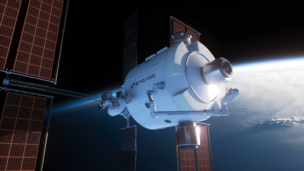Just hours after the Crew-3 launch Wednesday, the International Space Station (ISS) was forced to fire up its rockets and perform an unplanned engine burn. Roscosmos and NASA officials collaborated on the impromptu ISS reorientation.
- Why the maneuver? To evade a piece of space debris that was projected to get too close for comfort.
- Which debris? A shard of China’s former Fengyun-1C, which the nation controversially kaboomed in a 2007 anti-satellite (ASAT) test. Roughly 3k Fengyun-1C fragments are orbiting around Earth—idle threats for operational spacecraft.
- ASAT, a topic that’s top of mind for the UN, is a conversation we’ll have to save for another day.
- Fortunately, the maneuver didn’t impact the Crew-3 mission, which docked with the ISS last night. The ISS and crew are in no danger, Roscosmos said.
A pattern: The ISS has performed 29 of these evasive maneuvers since 1999, with three taking place last year alone. “Debris is getting worse!” then-NASA Administrator Jim Bridenstine tweeted last September.
Checks out. “We are going to see these maneuvers more frequently,” Moriba Jah told Payload in an interview. Jah is an astrodynamicist, UT Austin professor, NASA JPL alum, and chief scientific adviser of Privateer, which aims to be “Waze for space.” He’s one of the world’s foremost authorities on space debris, situational awareness, object-tracking, and the like.
Jah has been something of a Cassandra on the risks of overcrowding in space. “The thing that really dominates our perception of the risk is the uncertainty,” per Jah. At present, he said, space represents a tragedy of the commons, with “no coordination or planning in how participants behave and use the resource.”
Solutions? How can we improve the situation over our heads? Jah has thoughts:
- Get more eyes “on and in” the sky and merge ensuing datastreams into an accurate, all-encompassing view. “All sensors lie, every one has some bias.” You can mitigate distortions “by aggregating all the data and information” (ie, sensor fusion).
- Governments must stick to their word, whether it’s commitments under international law or non-binding space treaties. And that includes policing their national private space industry.
- “Recruiting empathy.” Jah, who moonlights as a science communicator, thinks the space community should try to break down walls, turn outward, and engage with the general public in non-jargony ways. A PhD shouldn’t be a prerequisite for understanding the value of responsible space stewardship (or caring about it).
+ Want more? On how Jah is operationalizing his views on cleaning up space? Or how he’s one of the “three amigos tied at the hip” with Privateer cofounders Steve Wozniak and Alex Fielding?
Read our full interview with Jah.




